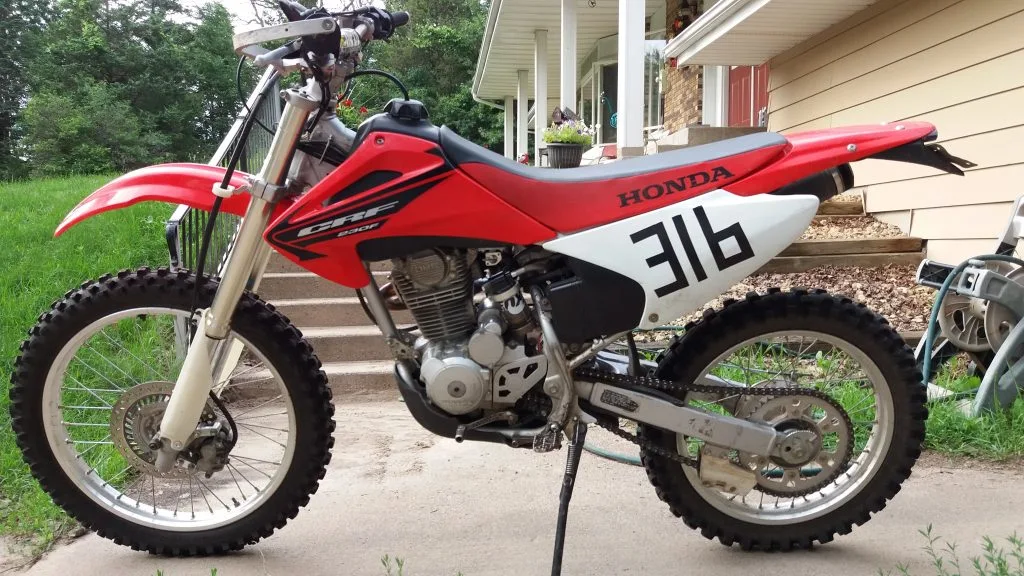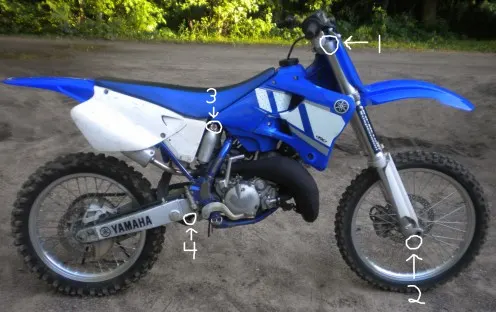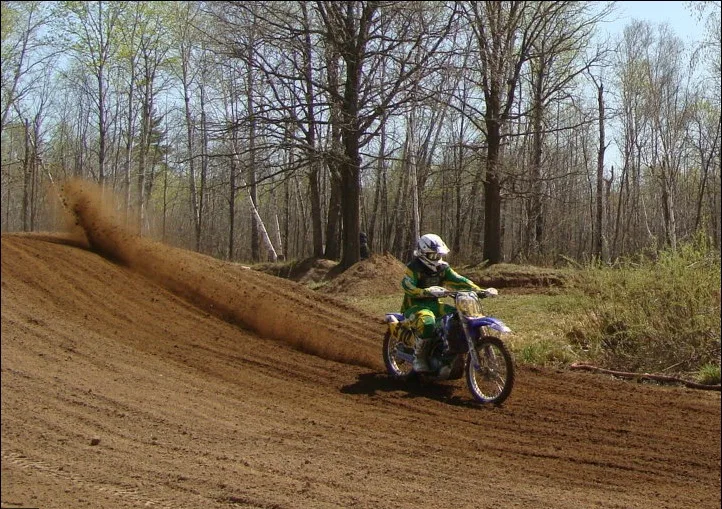Is your dirt bike suspension too soft but you’re not sure how to stiffen it? Whether you just bought your first dirt bike or you’ve just been too intimidated to work on your own suspension, you’re in the right place!
In this article, I’m going to show you how suspension works in a way that’s easy to understand, why it’s so important to get it properly set up for your weight and riding style, and the simple steps to do it yourself so that you save money and ride with more confidence!
How dirt bike suspension works - a simple explanation
While there are many different types and technologies of suspension for dirt bikes, they basically all work the same. The forks and shock are held up by a spring or air, and the internal parts control how fast or slow the suspension compresses and rebounds to give you comfort over bumps, jumps, and obstacles.

The adjustments are endless, so you can tune for your weight and adjust the speed that it compresses and rebounds to give you the most comfort.
Too many people pull their wallets out too quickly to send their suspension to a professional tuner when in reality, there are quite a few things you can do yourself for free to make most stock dirt bikes fit your specific needs.
How to find the “Perfect” suspension setting
We all want to get a “plush” feeling so that the suspension compresses enough over bumps and turns, yet “firm” enough so that it doesn’t bottom out on the biggest hits or jumps. Well, I hate to be the bearer of bad news, but there’s no “magical setting” that will do all of the above - at least not at the same time.
You see, suspension tuning is more or less a compromise. You can’t have it ultra stiff for huge jumps while still being super soft to absorb square edge bumps at low speeds.
Technology is good, but not that good…
You have to have one or the either, or somewhere in between. Dirt bike suspension technology has gotten a lot better so that you can have more of both, but you’ll never get the best of both worlds.
So, your goal is to tune for the most comfortable where you need it most, whether it’s for rock gardens, smooth-flowing trails, or dual sport riding on gravel roads.
Why your suspension is too soft
There are numerous possibilities why your suspension is too soft, whether it’s a tuning issue, or there’s actually something wrong with your forks or shock. Your job is to start with the easiest and most important things first, and then work your way towards more complicated or expensive things to make your dirt bike suspension work better for you.
The most likely reasons why your suspension is too soft are:
- The forks and/or shock springs are too soft (spring rate too light)
- The suspension is not balanced
- Not enough preload
- The clickers need to be tuned for your type of riding
- The valving is too soft
- Fork oil too low in forks
- Fork oil too light
What can happen if your shock or forks are too soft?
When your dirt bike suspension is too soft it will compress and bottom out. Bottoming out the suspension is simply when the forks and/or shock compress all the way to the bottom of the available travel and hit the limiter, which usually makes a “clunk” noise and a sudden harsh feeling in your handlebars.
Signs of discomfort and danger!
Not only is this uncomfortable, but it can be dangerous - to you and your dirt bike. It will cause you to get out of control because once all the suspension is used up, the stiff chassis will bounce off the ground from the hard impact.
This will also lead to frame or suspension damage if you consistently bottom out too often. The frame welds are usually the first to crack and then break, which can cause a serious accident that leads to you getting injured - exactly what we’re trying to prevent!
Why your dirt bike suspension can feel harsh when it’s too soft
When your off-road motorcycle suspension is too soft and under-sprung, it will ride too low in the suspension and feel harsh. This may sound confusing, but it’s pretty simple.
When the shock and fork springs are too soft, you’ll compress the suspension too much when you just sit on your bike. This puts it in the bottom half of the travel, which progressively gets stiffer, so when you hit a bump, it feels harsh or stiff - but in reality, it’s too soft for your weight.
Let me know in the comments below if that sounds too confusing to you.
Getting your suspension balanced before anything else
Before you even start adjusting the forks or shock and well before sending it out to get done, you need to make sure the suspension is sprung for your weight. This means that you need to make sure the springs are made for your weight and riding style.
Then, you need to balance the front and rear by setting the ride height. When your suspension is not balanced, it will handle poorly and you’ll be missing out on traction and control because the rear is too low or high.

You can do this by adjusting the rear shock sag. Refer to your OEM service manual for recommended sag numbers, but most full-size dirt bikes work well with 100mm of rider sag - that’s just a good starting point.
How to make your dirt bike suspension softer
Once you have the correct spring rates and it’s balanced, then you can focus on why your dirt bike suspension is too soft. We’ll focus on each problem, starting with the simplest things first.
These are the best ways to make your dirt bike suspension stiffer:
Front forks too soft
When the forks on your dirt bike are too soft, they’ll dive hard under braking and compress too much on small and large bumps. This can also cause the rear end to be too high, which makes it turn quicker and less stable.
To make your forks stiffer, you need to make sure you have the right springs for your weight. They should have a proper amount of sag when you sit on the seat so that it stays balanced with the rear end of your bike.
Pro tip: If you’re installing heavy-duty fork springs but find that it’s too stiff, you can try removing one and swapping it with a stock spring. With one stiffer and one stock, it will split the difference regarding the spring rate.
Rear shock is too soft
A shock that’s too soft will squat too much when you accelerate or ride up hills. This will give you more stability, but the front end will have a lot less traction and control, and it will also be harder to steer.
This will give you that "chopper style" look when the rear end is too low.
Getting the right shock spring for your weight is critical here, and then adjusting the sag/ride height will get it balanced. The sag/shock preload is quick to adjust with a shock collar spanner wrench (Amazon).

Adjusting the clickers
Once you get the right springs and ride height, you can move to the clickers - if your dirt bike has them. It’s a small screw on the top and/or bottom of the forks and shock that can be adjusted with a flat-blade screwdriver.
The compression and rebound clickers control how much fluid/oil flows by when your suspension moves. Slowing down the fluid makes it stiffer, and speeding up the fluid flow makes it feel softer.

How to adjust the clickers
To make the compression or rebound damping clickers stiffer, turn it in (clockwise). To make it softer, turn the clickers out (counterclockwise).
You will hear a small “click” when you rotate the screw. Most dirt bikes have around 10-20 “clicks” of total adjustment. Sometimes more, sometimes less.
Stock is usually in the middle (10 clicks out from all the way in). 1-2 clicks of adjustment can make a difference if you’re an experienced rider. If you’re a beginner, you might have to adjust it 5 clicks or more to feel a change in the suspension.
Fork Preload
Adding preload to your dirt bike forks can make them feel stiffer and is one of the easier things to do because it usually doesn’t require taking them fully apart. Adding preload is similar to increasing the spring rate - it holds the forks up higher in the stroke so that you have more travel available to compress when hitting bumps and obstacles.

Some modern enduro bikes or motocross have external pre-load adjustment, but most require you to add a pre-load spacer internally. Something as simple as a PVC pipe spacer properly sized can be done for cheap, but please refer to your OEM service manual or local tuner that you trust for exact specs.
Oil weight
Fork and shock oil weight can control how stiff or soft they feel. Since the oil is being pushed through holes and valving stacks, using heavier-weight oil will make it harder to push through and make it feel stiffer.
While this won’t make a dramatic change, it’s very easy, cheap, or free to do if you already have your forks or shock apart or need to get them serviced soon anyway.
Oil height/air gap
When you change the amount of oil in your forks, the amount of air changes. Air is easier to compress than oil, so if you raise the oil height/level, there’s less air, making it harder to compress and feel stiffer.
The oil height mostly affects the suspension stiffness near the end of the travel and the bottoming resistance. You can also add too much oil into the forks and cause the seals to blow out and leak, so please refer to your manual for minimum and maximum oil height levels.

Internal re-valving
Once you’ve tried all of the above yourself, which are either FREE or relatively cheap, and you’re still frustrated that your dirt bike suspension is too soft still - then it might be time to send it to a professional to get some internal valving changes.
While most of the external suspension adjustments are pretty simple on a dirt bike, the internal valving is quite complicated and I consider it to be an “art”. It’s easy to mess it up, so if you don’t know what you’re doing or aren’t highly inclined mechanically, I suggest you bring it to a dirt bike suspension professional that’s familiar with your specific dirt bike forks and shock.
The problem with sending out your suspension
A common mistake that people make is getting a suspension re-valve too soon or right away after buying their dirt bike. Not only can this be expensive, but it may not even help as much as you hope.
You see, if you haven’t already tried the easier ways to make your dirt bike suspension stiffer that is listed above, then you don’t know what exactly your bike needs to make it better for YOU. If you just drop it off or ship it to a tuner and say “make it better”, how are they going to know what needs to be done?
Even if you say, “It’s too soft”, that’s still too generic and not very helpful because it could be:
- Too soft with the springs
- The mid valve is too soft
- The bottoming resistance is too soft
- All of the above, or something else
The more specific information you can give your suspension tuner, the better he or she will be able to help you and the less likely you’ll have to send it back because it’s “not as much of an improvement” as you’d hoped for.
Top 3 mods that are free or cheap
While DIY suspension tuning is one of the easiest ways to make your dirt bike more comfortable to give you more confidence, there are other ways to quickly boost your confidence and control to make you not only faster, but ultimately safer - click here to learn how.

